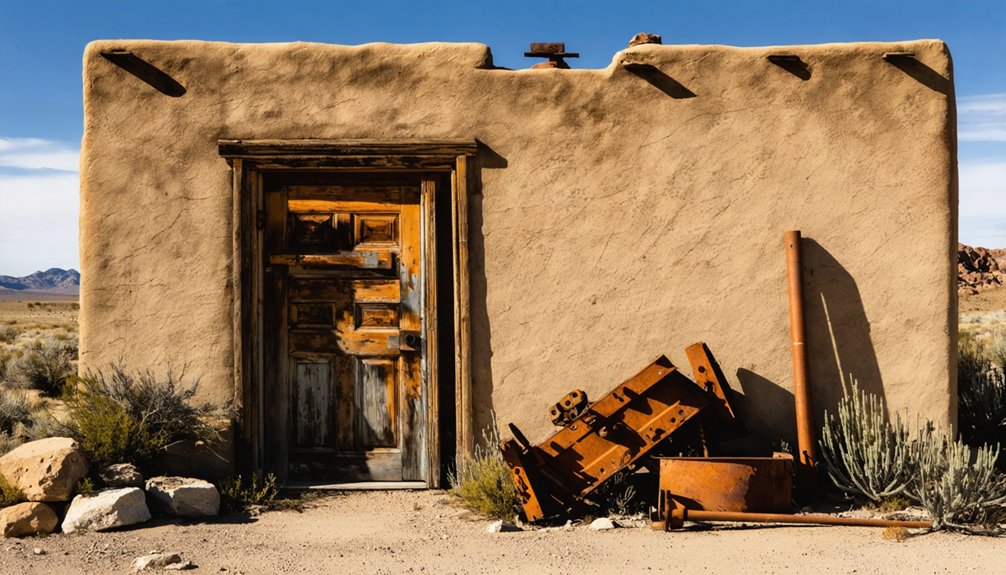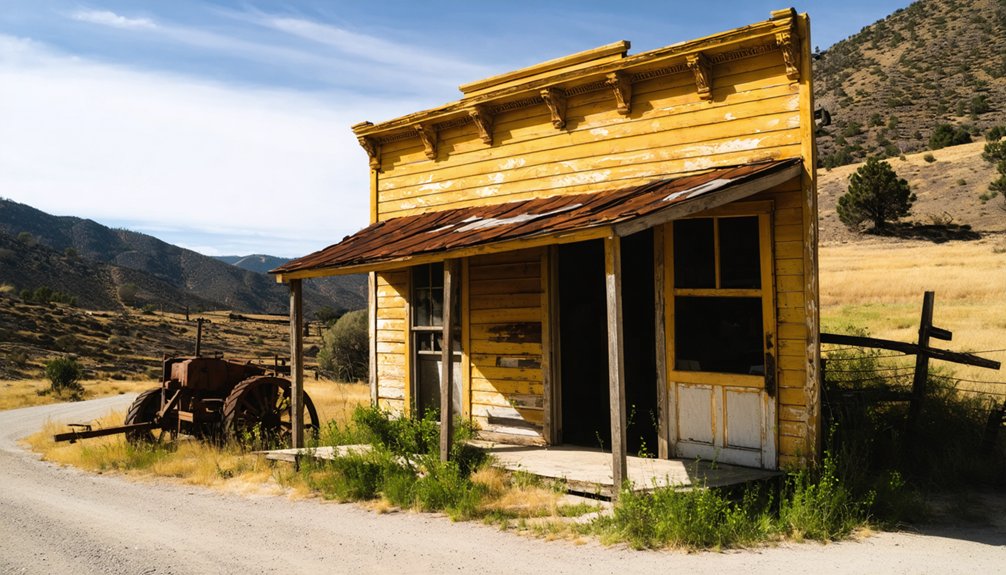You’ll find Benita ghost town 31 miles southwest of Delano in Kern County, where it once thrived as California’s third-largest city during the 1870s gold rush with over 10,000 residents. Today, only 5% of the original structures remain, including scattered foundation stones and weathered timber fragments. While currently closed through mid-2025 due to the Palisades Fire, this former boomtown holds fascinating stories of mining prosperity, agricultural ventures, and dramatic population shifts.
Key Takeaways
- Located 31 miles southwest of Delano in Kern County, Benita’s exact location remains disputed due to landscape changes and documentation limitations.
- The town peaked at 10,000 residents during the 1870s gold rush before declining in the 1880s and becoming officially abandoned by 1940s.
- Only 5% of original structures remain, featuring scattered foundation stones, weathered timber fragments, and metal artifacts amid natural reclamation.
- Core industries included agriculture, mining, and oil production, with lemon orchards and dairy farms dominating until the devastating 1894 drought.
- The site is currently closed through mid-2025 due to the Palisades Fire, with no permanent residents but typically 200,000 annual visitors.
The Mystery Behind Benita’s Location
Where exactly did the ghost town of Benita stand?
You’ll find significant geographic discrepancies in trying to answer this question. Historical records place it roughly 31 miles southwest of Delano in Kern County, but you won’t find precise coordinates in modern mapping.
The challenge stems from archival limitations and physical transformation of the landscape. Agricultural development, natural erosion, and vegetation growth have likely obscured or erased original site markers. Similar to how disambiguation pages help researchers distinguish between locations with similar names, historical records must be carefully analyzed to avoid confusing Benita with other sites.
Time and agriculture’s march forward has erased the physical traces, leaving only fading memories of what once stood here.
The Sweetwater Valley Civic Association fought to maintain the rural character of nearby regions, making it harder to determine where Benita once existed.
You’ll discover that some sources confuse Benita with similarly named places like Bonita or El Bonita, which makes pinpointing the location even more difficult.
Without documented archaeological excavations or standing structures, and given the extensive changes to the region’s topography over time, Benita’s exact location remains one of California’s unsolved geographic mysteries.
Historical Records and Documentation
Although historical records of Benita remain sparse, surviving documents reveal a complex alteration of land ownership from Spanish colonial rule through Mexican independence and into American annexation.
Through careful archival research, you’ll find these significant records have shaped our understanding of the area’s transformation. Similar to other ghost town records, these documents provide crucial insights into California’s cycles of prosperity and decline. The area shares characteristics with towns like Hornitos, where original structures still stand today.
- Land grant maps and tax documents trace ownership changes from El Rancho del Rey through Forster’s Rancho de la Nación
- Documentation preservation efforts by the Bonita Historical Society maintain essential exhibits and oral histories
- Archaeological surveys near Sweetwater Dam reveal Kumeyaay settlements and stone tool artifacts
- Mission records and early American tax documents detail the change from indigenous lands to Spanish cattle ranching
The paper trail tells a story of shifting powers, where each era left its mark through official documentation and land use records.
Life in Early Settlement Days
Beyond the written records and official documents, the physical remnants and oral histories paint a vivid picture of life in early Benita. You’d find simple settlement architecture reflecting the community’s agricultural roots – from seasonal Kumeyaay willow pole huts to later wood and adobe ranch houses.
Daily life centered around lemon orchards and dairy farms, particularly after Chinese immigrants introduced diverse farming practices in the mid-1800s. Community gatherings brought settlers together through dances, fairs, and pioneer celebrations, while post offices and general stores served as essential communication hubs.
You’d navigate unpaved roads and face seasonal challenges, especially during El Niño floods that often cut off access at river crossings. The 1888 Sweetwater Dam‘s construction – and its devastating 1906 failure – fundamentally altered both the settlement patterns and daily routines of Benita’s inhabitants.
Economic Activities and Local Industries
Three core industries shaped Benita’s economic landscape: agriculture, mining, and oil production.
You’ll find that lemon orchards and dairy farms dominated the agricultural scene, while mining operations extracted gold, silver, copper, and other minerals throughout Kern County. The oil sector complemented these activities, though its impact fluctuated with boom-and-bust cycles. Similar to the ghost town of Bodie, which produced over $14 million in precious metals, Benita’s mining operations were highly profitable in their prime years. The devastating drought of 1894 severely impacted local farming operations and forced many settlers to abandon their agricultural pursuits.
Sprawling lemon groves and dairy operations shared the landscape with bustling mines and oil wells, creating a diverse economic tapestry.
Key economic transformations you should know about:
- Agricultural shifts occurred post-WWII when housing developments became more profitable than farming.
- Mining decline led to the abandonment of several local settlements as ore sources depleted.
- The creation of 181 housing lots within five years marked a significant economic pivot.
- Local businesses evolved from basic services to include shopping centers and paid fire departments.
These changes ultimately transformed Benita from a resource-based economy to a ghost town.
Population Changes Over Time
When gold was discovered in the region, Benita’s population surged dramatically, reaching an estimated peak of over 10,000 residents during the late 1870s.
You’ll find that this population explosion transformed Benita into California’s third-largest city, complete with a thriving Chinatown and diverse immigrant communities.
The population dynamics shifted dramatically as mining activities declined in the 1880s.
You’d have witnessed major demographic shifts as residents departed en masse, with the remaining population primarily consisting of male miners.
During World War II, the area experienced a brief resurgence as the population doubled to 7,000 due to the economic boom.
By the 1940s, the town was officially designated a ghost town.
Today, you won’t find any permanent residents in Benita. While over 200,000 visitors explore the town annually, only seasonal park staff and researchers temporarily occupy the area, preserving its structures in a state of “arrested decay.”
Geographical Features and Landscape
Nestled within Kern County’s high desert basin, Benita occupied a distinctive landscape approximately 31 miles southwest of Delano. The terrain featured sandy valleys, rocky slopes, and desert vegetation adapted to the semi-arid climate. The moderate incline made it suitable for easy-to-moderate hiking, similar to many trails in Southern California’s wilderness areas.
The nearby Kern River shaped the region’s geography, while the San Andreas Fault influenced local seismic activity.
The area’s wildlife diversity and natural features include:
- Desert-adapted plants and scrub across the valley floor, with forested zones at higher elevations
- Native wildlife like coyotes, bobcats, foxes, and rabbits roaming the open spaces
- Elevation changes of about 300 feet over short distances, creating moderate relief
- A closed basin system limiting natural drainage, resulting in dry conditions except near water sources
Modern-Day Site Conditions

If you’re planning to visit Benita’s ruins today, you’ll need to navigate challenging access routes that have deteriorated markedly since the town’s abandonment.
Visitors should be aware that only five percent remains of what was once a bustling mining settlement. The remaining physical features include scattered foundation stones, weathered timber fragments, and occasional metal artifacts that hint at the town’s mining history. Similar to other abandoned mining towns like Cerro Gordo in California, accessing deeper underground structures presents significant safety challenges.
Natural revegetation has gradually reclaimed much of the original townsite, with native plants and erosion patterns reshaping the landscape over the decades.
Current Site Access Challenges
Although Benita ghost town holds significant historical value, modern-day access to the site faces multiple challenges stemming from the 2025 Palisades Fire emergency declaration.
Site restrictions have closed all parks, trails, and public accessways connected to Pacific Coast Highway near the ghost town, while visitor navigation remains difficult due to limited signage and infrastructure.
- You’ll encounter strict emergency closures affecting the entire Malibu coastal region through mid-2025.
- You can’t rely on public transportation, as no major links serve the ghost town area.
- You’ll need to watch for ongoing road construction and utility projects that cause detours.
- You must be aware of sudden closures due to environmental hazards like landslides and wildlife protection measures.
Physical Features Today
Beyond the access restrictions lies a haunting landscape of structural decay and natural reclamation at Benita’s ghost town site.
You’ll encounter mostly skeletal remains of buildings, their shells exposed to the elements and gradually crumbling. The architectural decay is evident in compromised foundations, deteriorating basements, and unstable structural remnants marked by old caution tape.
Natural forces continue to reshape the site as vegetation encroachment steadily advances. Tumbleweeds and desert flora dominate the rough, undeveloped terrain, while overgrowth obscures many remaining features.
Underground spaces hint at the town’s former life, though these areas show significant deterioration. The site’s current state reflects years of abandonment – a raw, untamed landscape where nature’s slow reconquest of human-made structures creates an atmosphere of desolation and untethered wilderness.
Environmental Changes Over Time
Recent climate shifts have dramatically transformed Benita’s landscape, with rising temperatures and intensifying droughts reshaping the ghost town‘s remnants.
The climate impact on this historic site mirrors broader environmental changes seen across California’s ghost towns, testing the area’s environmental resilience.
- You’ll notice vegetation patterns changing as drought conditions intensify, similar to Lake Isabella’s dramatic water loss that’s exposed long-submerged structures.
- You can witness firsthand how wildfires threaten historic structures, much like the destruction of Shasta City and Helena.
- You’ll find preserved open spaces covering nearly 1,000 acres, maintaining wildlife corridors despite urban encroachment.
- You can observe ongoing environmental assessments that monitor potential contamination, ensuring the site’s safety while preserving its historic character.
Regional Context and Similar Settlements

While California’s landscape is dotted with numerous ghost towns, Benita’s location in Kern County places it within a rich tapestry of abandoned settlements that share similar historical trajectories.
You’ll find that settlement patterns in this region evolved from Native American territories to Spanish colonial missions and Mexican land grants, ultimately transforming during American governance.
Like many ghost towns, Benita’s story mirrors nearby communities that rose and fell with single-industry economies.
Throughout California, you’ll discover abandoned towns that emerged during resource booms, only to face decline through resource depletion, economic shifts, or natural disasters.
These communities often left behind physical remnants of their brief existence, from mining equipment to agricultural tools, providing tangible links to California’s frontier past.
Frequently Asked Questions
Were Any Artifacts or Personal Belongings Ever Found in Benita?
You won’t find any documented artifact discoveries or personal belongings from this location – zero credible archaeological reports exist, unlike California’s Bodie ghost town with its 10,000+ recovered artifacts.
Did Native American Tribes Have Any Connection to the Benita Area?
You’ll find the Kumeyaay people held strong native connections to this region, evidenced by their settlements and artifacts. Their tribal significance is documented through archaeological findings near Sweetwater Valley and surrounding areas.
What Natural Disasters or Events Might Have Affected Benita?
You’d have found major flood impacts from the 1906 Sweetwater Dam failure, recurring El Niño flooding at Central Avenue crossing, and widespread agricultural damage from severe droughts and deep freezes.
Are There Any Surviving Photographs or Maps of Benita?
Persistent probing through archival research hasn’t revealed any surviving photographs or maps. You won’t find historical documentation of Benita in publicly available collections, suggesting the need for deeper local archive exploration.
Did Any Famous Historical Figures Ever Visit or Mention Benita?
You won’t find any documented famous visitors or historical mentions of this place – research shows no evidence of notable figures ever visiting or discussing this small settlement.
References
- https://www.youtube.com/watch?v=OD9M6MP6RRU
- https://en.wikipedia.org/wiki/Bonita
- https://bonitahistoricalsociety.org/history-of-sweetwater-valley/
- https://www.mexinsurance.com/history-of-bonita-california/
- https://kids.kiddle.co/Benita
- https://pastmaps.com/explore/us/california/sonoma-county/el-bonita/metal-detecting
- https://www.hauntedplaces.org/bonita-ca/
- https://forgottennevada.org/sites/bonita.html
- https://en.wikipedia.org/wiki/List_of_ghost_towns_in_California
- https://www.youtube.com/watch?v=lgp6IPVFX2Q



